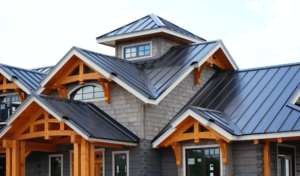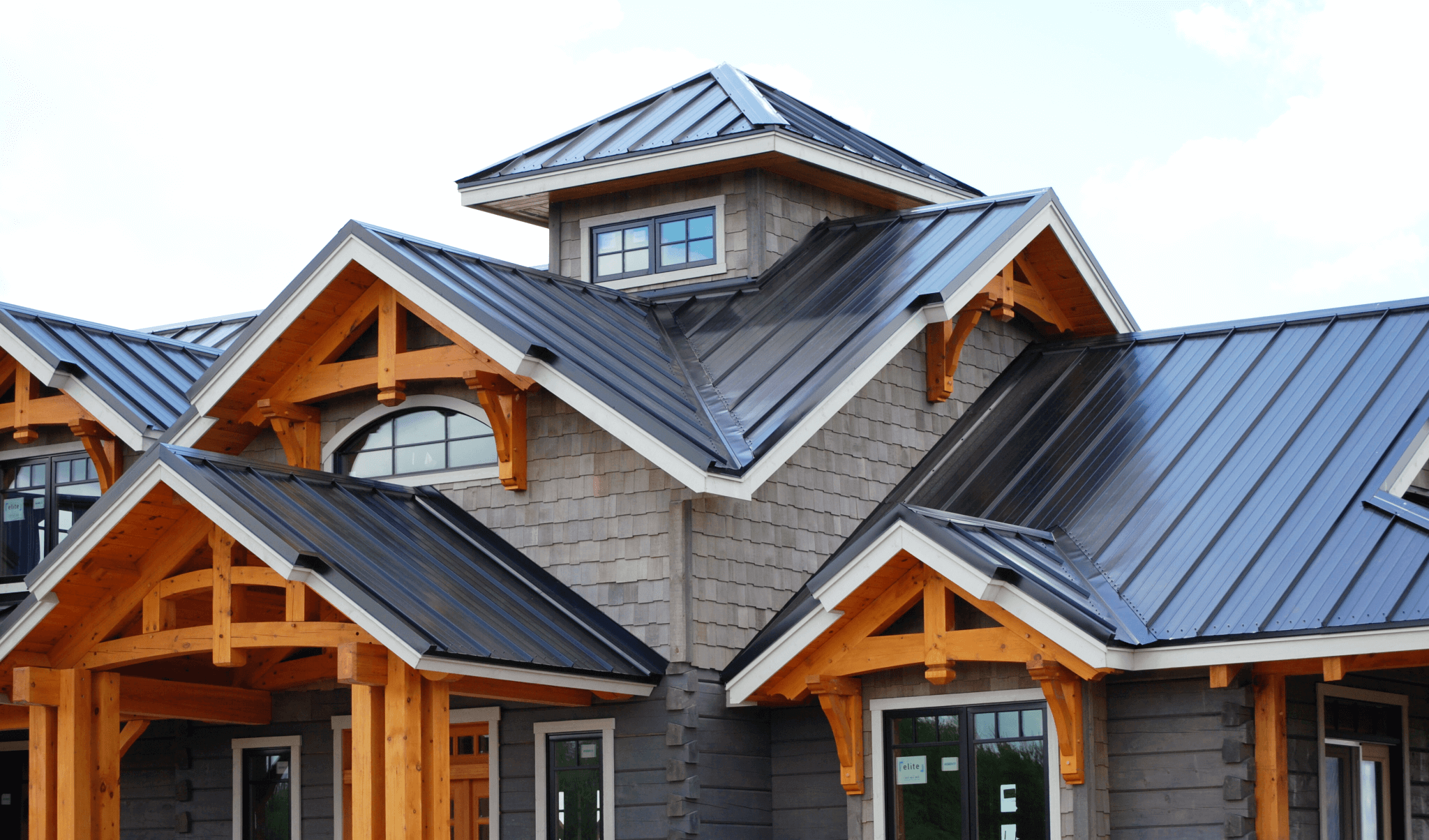If you’ve ever stood under a metal-clad pole barn or garage roof in a rainstorm, you’ve heard that loud pinging noise. However, on a residential roof, layers of building materials between the metal and the living space minimize sound transmission.

High-quality standing seam metal roofing panels are snapped together and seamed mechanically, concealing the fasteners. Cheaper panels with exposed fasteners will require maintenance over time.
A metal roof can last a long time and resist a variety of environmental threats. Unlike asphalt shingles, which can crack or fade in sunlight, metal roofing resists heat, cold, heavy rains, and hail. Depending on the material, metal roofs can also resist mold and mildew growth. It is not uncommon to find a home with a metal roof still intact, decades after it was installed.
Modern residential metal roofs are made of galvanized or aluminum-zinc-coated steel. They are usually coated with a protective finish and come in a wide range of colors. Some metals, such as copper and zinc, are naturally durable without being painted or covered with a protective coating.
Like other roofing materials, metals expand and contract as they warm up or cool down, so it is important that fasteners are properly designed to accommodate these movements. Most new metal roof panels have pre-installed expansion and contraction joints to help minimize any movement issues that may occur.
In addition to having a long lifespan, metal roofs are also low-maintenance. Most of the maintenance is done on a regular basis by cleaning the surface with a hose and a pressure washer to remove any debris that accumulates. In addition, metal roofs should be inspected regularly to identify and correct any potential problems.
Some metal roofing is insulated, which can save on cooling costs and reduce the risk of condensation problems. Additionally, a reflective metal roof can significantly cut energy bills by reflecting the sun’s rays rather than absorbing them.
The longevity of a metal roof depends on several factors, including quality, design and installation, weather conditions, and maintenance. For example, an incorrectly sloped roof can cause water to pool, which can weaken the metal. Properly installing insulation and a ventilation system can help prevent this problem.
Another factor that can affect the durability of a metal roof is how often it is exposed to direct sunlight. In general, darker-colored metal roofs are more likely to be damaged by ultraviolet rays than lighter-colored ones. In some cases, this can lead to the need for repairs or a complete roof replacement sooner than would otherwise be necessary.
Recyclability
Unlike many other roofing materials that end up in landfills, metal roof panels are 100 percent recyclable. They can be recycled into new roofs, or they can be melted down and used to create other metal products. This makes them a better choice for sustainable building than asphalt shingles.
Metal roofing is also a good option for green construction because it helps reduce energy costs. The material reflects sunlight, which cuts down on the need for air conditioning in warm weather and insulation during colder months. In addition, many metal roofing systems come with a warranty that lasts up to 50 years.
This long-term durability can help you save money on maintenance and repair expenses, making them a more affordable option in the long run. It is also a fire-resistant material, which can cut down on insurance premiums and qualify you for a tax credit.
In addition, metal roofs are much more environmentally friendly than shingle roofs because they don’t pollute the environment with asphalt and other chemicals. They are also lightweight, allowing them to be easily installed over existing roofs without the need for expensive tear-offs. This helps to conserve landfill space and reduce the amount of waste that is sent to the trash.
Another advantage of metal roofs is that they can be recycled many times over their lifespan. In some cases, the metal can be repainted and refurbished to look like new. Many manufacturers also offer recycling programs, which allow customers to send their old metal roofing panels back to them when they are ready for new paint or refinishing.
One myth that is sometimes associated with metal roofs is that they are more likely to attract lightning. In reality, lightning rarely hits residential roofs at all. It is more likely to strike tall buildings or trees, and if it does hit your roof, it will most often hit the underside of the panel. This is why most roofing manufacturers do not recommend that you install a grounding system for your metal roof. However, you should make sure to have proper homeowner’s insurance coverage if you live in an area where lightning can cause significant damage to shingles and other roofing materials.
Aesthetics
When homeowners invest time and money into a roofing project, they want to make sure their home looks great. A metal roof offers many aesthetic advantages that help achieve this. The most obvious is the appearance of a sleek, clean, and modern roof. This is made possible by the fact that metal panels are available in a wide variety of colors and finishes, making it possible to match almost any home facade.
The classic type of metal roof you might expect to see on a shed or barn is the corrugated panel style. This looks fine on agricultural buildings, but it can leave something to be desired for residential homes that are popularized for their curb appeal. A newer and much more appealing option is the standing-seam metal roof. This is a panel type that can be used as an architectural accent or a complete building roof, and it offers a more sophisticated look than the corrugated panels. This panel design interlocks with hidden fasteners to create a clean, modern appearance.
Other styles of metal roofing also exist to meet the needs of a broad range of architectural styles. For instance, metal roof products that simulate natural slate, tile, and cedar shingles can offer advanced protection with a more attractive aesthetic.
In addition to the variety of profiles and colors, metal roofs can also be customized with a large selection of trims. This allows homeowners to choose the style that fits their house best, and it helps ensure that the color of the roof is a perfect complement to the rest of the house’s exterior.
In fact, using a combination of different colors, styles, and trims is one of the current trends in the field of metal roofs. Using color to highlight features of the house like dormers or entryways is a way to add even more visual interest. For this reason, a metal roof can truly be a statement piece that transforms the entire exterior of the home.
Energy Efficiency
Many homeowners today are conscious of their environmental impact and want to make eco-friendly choices when it comes to their home improvement projects. Among the most popular are green appliances and fixtures, energy-efficient lights and windows, and metal roofs. While a quality metal roof is more expensive than asphalt shingles, it will pay for itself in lower air conditioning bills and increased resale value.
The most significant advantage that metal roofing has over other roofing materials is its energy efficiency. This is due to the fact that it reflects sunlight instead of absorbing it, which can keep the interior of your home cooler during the summer months without increasing your air conditioning usage.
In addition, because a metal roof is reflective, it will hold the heat in your house during the winter, keeping it warmer inside and decreasing heating costs. Metal roofs are also designed to be durable and withstand harsh weather conditions, such as strong winds, hail storms, heavy snowfall, and tropical storms. They can withstand the elements for 40 years or more with very little maintenance required.
A recent study funded by the Department of Energy shows that a white, galvanized metal roof can save energy costs by up to 45% over traditional roofing. The reason for this energy savings has to do with how a metal roof is installed. When a metal roof is installed properly using a batten or counter-batten system, the space created allows for airflow underneath the roof and decreases heat transfer into your home.
Another factor that increases the energy efficiency of a metal roof is its lightweight. This makes it easier to install and less likely to need maintenance than other types of roofing.
If you’re interested in adding a new roof or replacing your existing one, contact the expert team at Texas Metal Roofing today. We can help you select the right type of metal roofing for your project and provide a free estimate. We’re here to answer any questions that you may have about our products or the installation process, and we can show you examples of quality metal roofing in action.
